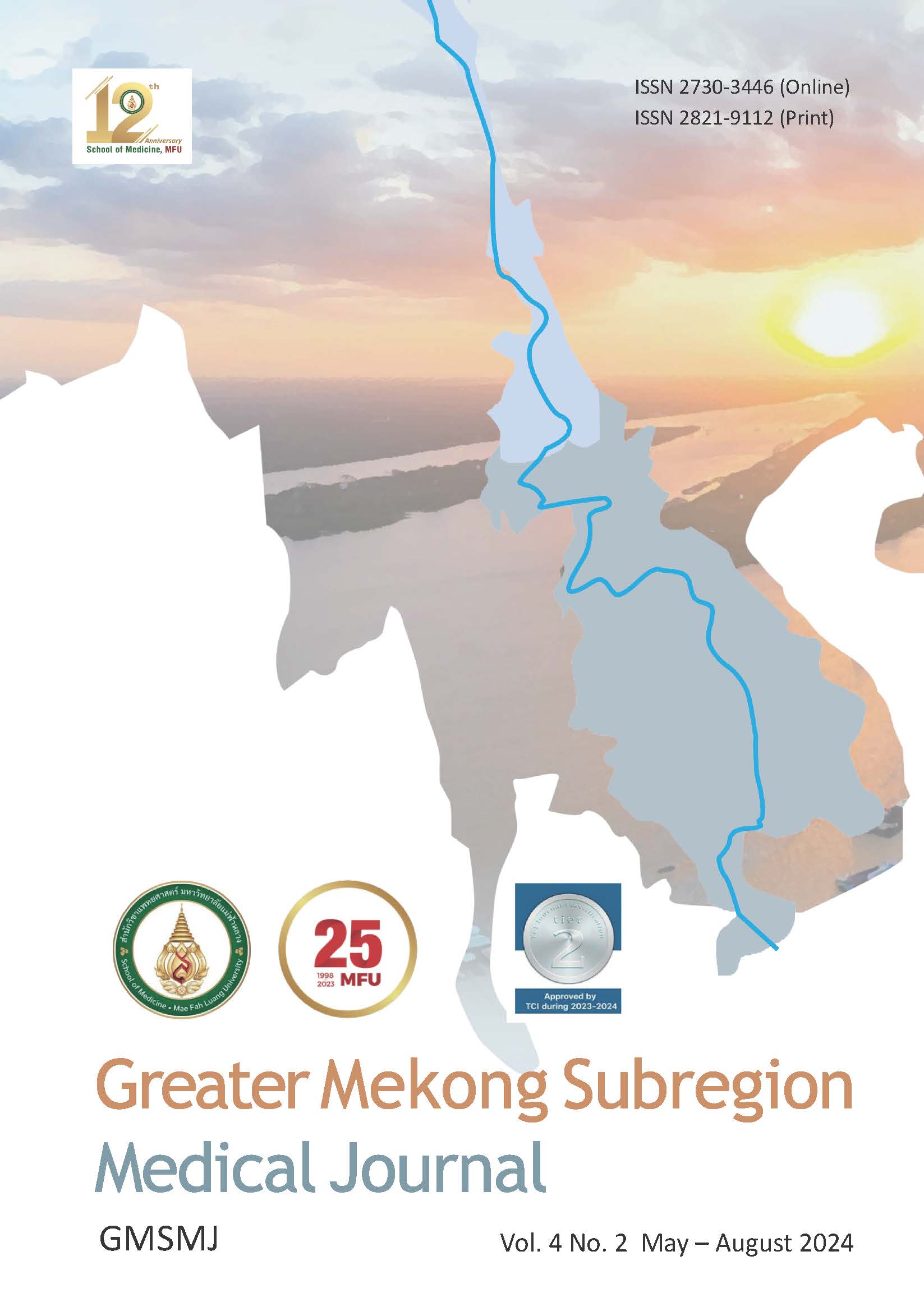The Processing and Characterization of the New Semi-absorbable Bone Wax Made from Rice Starch Blended with Beeswax
Keywords:
Beeswax, Bone wax, Rice starch, Semi-absorbable, Hemostatic agentAbstract
Background: In the 21st century, bone wax is one of the most prevalent biomaterials to help mechanically control bleeding from bone surfaces in almost every surgical procedure. It is bio-inert, albeit a foreign body with non-absorbability, and rarely causes complications such as granuloma and persistent serous discharge. Semi-absorbable bone wax is an encouraging alternative since it highly reduces the risk of harmful response reactions on the host, which is what we primarily aim for.
Objective: This research studied the amount of medical-grade rice added to beeswax with different amounts of addition. It is used as a semi-absorbable hemostatic agent to improve the biodegradable efficiency of beeswax.
Materials and Method: Material characteristics such as scanning electron microscopy (SEM), melting point, Fourier transform infrared spectroscopy (FTIR), and water diffusibility are used to study the effect of adding rice starch powders. Bone wax is prepared from the mixture of white beeswax with isopropyl palmitate and liquid paraffin and three different compositions of rice starch powders in aqueous suspension (30, 40, and 50 wt %).
Results: The addition of rice starch powder increases the absorbability mechanism, smoothness, and whiteness and can be easily smeared on the bone surface. We have concluded that an optimized composition of 40 wt % rice starch powder has adequate quality for utilizing it as a semi-absorbable bone wax.
Conclusion: Rice starch that is incorporated into bone wax is more bio-absorbable than the original bone wax itself and will furthermore undergo additional testing in animal laboratories.
References
Kearon C. Epidemiology of venous thromboembolism. Semin Vasc Med. 2001; 1 (1): 7-26. doi: 10.1055/s-2001- 14668
Seng S, Liu Z, Chiu SK, Proverbs- Singh T, Sonpavde G, Choueiri TK, et al. Risk of venous thromboembolism in patients with cancer treated with cisplatin: A Systematic Review and Meta-Analysis. J Clin Oncol. 2012 30 (35): 4416-26. doi: 10.1200/JCO. 2012.42.4358. https://doi.org/10.1200/jco.2012.30.15_suppl.e21016
Agnelli G, Verso M. Management of venous thromboembolism in patients with cancer. J Thromb Haemost. 2011; 9 (Suppl 1): 316-24. doi: 10.1111/j.1538- 7836.2011.04346.x. https://doi.org/10.1111/j.1538-7836.2011.04346.x
Kourlaba G, Relakis J, Mylonas C, Kapaki V, Kontodimas S, Holm MV, et al. The humanistic and economic burden of venous thromboembolism in cancer patients. Blood Coagul Fibrinolysis. 2015; 26 (1):13-31. doi: 10.1097/MBC.0000000000000193. https://doi.org/10.1097/MBC.0000000000000193
Virchow R. Gesammelte Abhandlungen zur Wissenschaftlichen Medicin. Medical Heritage Library. Frankfurt A. M.: Meidinger Sohn & Comp, 1856.
Rosendaal FR. Venous thrombosis: a multicausal disease. Lancet. 1999; 353: 1167-73. doi: 10.1016/s0140-6736 (98)10266-0. https://doi.org/10.1016/S0140-6736(98)10266-0
Prandoni P, Lensing AWA, Piccioli A, Bernardi E, Simioni P, Girolami B, et al. Recurrent venous thromboembolism and bleeding complications during anticoagulant treatment in patients with cancer and venous thrombosis. Blood. 2002; 100 (10): 3484-8. https://doi.org/10.1182/blood-2002-01-0108
Yamashita Y, Morimoto T, Amano H, Takase T, Hiramori S, Kim K, et al. Anticoagulation therapy for venous thromboembolism in the real world- From the COMMAND VTE Registry. Circ J. 2018; 82 (5):1262-70. doi: 10.1253/circj.CJ-17-1128. https://doi.org/10.1253/circj.CJ-17-1128
Lee AYY, Levine MN, Baker RI, Bowden C, Kakkar AK, Prins M, et al. Low-Molecular-Weight Heparin versus a coumarin for the prevention of recurrent venous thromboembolism in patients with cancer. N Engl J Med. 2003; 349 (2): 146-53. doi: 10.1056/ NEJMoa025313. https://doi.org/10.1056/NEJMoa025313
Kahale LA, Hakoum MB, Tsolakian IG, Alturki F, Matar CF, Terrenato I, et al. Anticoagulation for the long-term treatment of venous thromboembolism in people with cancer. Cochrane Database of Sys Rev. 2018 Jun 19; 6: CD006650. https://doi.org/10.1002/14651858.CD006650.pub5
Raskob GE, van Es N, Verhamme P, Carrier M, Di Nisio M, Garcia D, et al. Edoxaban for the treatment of cancerassociated venous thromboembolism. N Engl J Med. 2018; 378 (7): 615-24. https://doi.org/10.1056/NEJMoa1711948
Young AM, Marshall A, Thirlwall J, Chapman O, Lokare A, Hill C, et al. Comparison of an oral factor Xa inhibitor with low molecular weight heparin in patients with cancer with venous thromboembolism: Results of a randomized trial (SELECT-D). J Clin Oncol. 2018; 36 (20): 2017-23. https://doi.org/10.1200/JCO.2018.78.8034
Agnelli G, Becattini C, Meyer G, Muñoz A, Huisman MV, Connors JM, et al. Apixaban for the treatment of venous thromboembolism associated with cancer. N Engl J Med. 2020; 382 (17): 1599-607. https://doi.org/10.1056/NEJMoa1915103
Schrag D, Uno H, Rosovsky R, Rutherford C, Sanfilippo K, Villano JL, et al. Direct oral anticoagulants vs low-molecular-weight heparin and recurrent VTE in patients with cancer: A Randomized Clinical Trial. JAMA. 2023; 329 (22): 1924-33. DOI: 10.1001/jama.2023.7843.
Wiggins BS, Dixon DL, Neyens RR, Page RL, Gluckman TJ. Select drugdrug interactions with direct oral anticoagulants. J Am Coll Cardiol. 2020 75 (11): 1341-50. https://doi.org/10.1016/j.jacc.2019.12.068
Lyman GH, Carrier M, Ay C, Di Nisio M, Hicks LK, Khorana AA, et al. American Society of Hematology 2021 guidelines for management of venous thromboembolism: prevention and treatment in patients with cancer. Blood Adv. 2021; 5 (4): 927-74. https://doi.org/10.1182/bloodadvances.2021004734
Mazzolal L, Alatri A. Treatment of cancer-associated venous thromboembolism [Internet]. www.escardio.org. [cited 2024 Mar 31]. Available from: https://www.escardio.org/Councils/ Council-for-Cardiology-Practice- (CCP)/Cardiopractice/treatmentof- cancer-associated-venous-thromboembolism.
NCCN.org. 2023. [Cited 2024 Mar 31]. Available from: https://www.nccn.org/professionals/physician_gls/pdf/vte.pdf.
Loncharich A, Lou S, Gage BF, Afzal A, Schoen MW, Sanfilippo KM. Risk factors associated with anticoagulantrelated bleeding in patients with cancerassociated thrombosis. Blood. 2023; 142 (Supplement 1): 5112. https://doi.org/10.1182/blood-2023-191029
Yamashita Y, Morimoto T, Amano H, Takase T, Hiramori S, Kim K, et al. COMMAND VTE Registry Investigators (2018). Anticoagulation therapy for venous thromboembolism in the real world- From the COMMAND VTE Registry. Circ J. 2018; 82 (5), 1262-70. doi: 10.1253/circj.CJ-17-1128. https://doi.org/10.1253/circj.CJ-17-1128
Kaneda K, Yamashita Y, Morimoto T, Chatani R, Nishimoto Y, Ikeda N, et al., COMMAND VTE Registry-2 Investigators (2023). Anticoagulation strategies and long-term recurrence in patients with venous thromboembolism in the era of direct oral anticoagulants. Eur J Intern Med. 2023; 118: 59-72. doi: 10.1016/j.ejim.2023.08.007. https://doi.org/10.1016/j.ejim.2023.08.007
Downloads
Published
How to Cite
Issue
Section
License
Copyright (c) 2024 Greater Mekong Subregion Medical Journal

This work is licensed under a Creative Commons Attribution-NonCommercial-NoDerivatives 4.0 International License.






